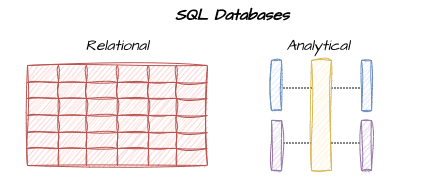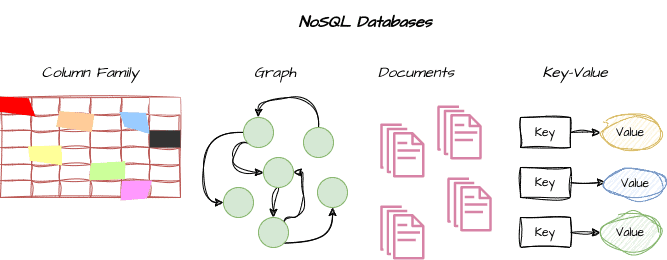Learn through the super-clean Baeldung Pro experience:
>> Membership and Baeldung Pro.
No ads, dark-mode and 6 months free of IntelliJ Idea Ultimate to start with.
Last updated: March 18, 2024
Databases play an important role in computer science since they are the central mechanism for storing, organizing, managing, and retrieving huge amounts of data.
In terms of database management systems, there are two basic types: SQL and NoSQL.
In this tutorial, we’ll examine the properties of SQL and NoSQL databases and present a guide to assist in choosing between the two.
SQL (Structured Query Language) databases provide information accuracy by maintaining strong data consistency and supporting complex transactions. They are well-suited for operations requiring organized data and a high level of data integrity due to their unified approach, which allows them to work with various frameworks and platforms:

They also maintain the relational model, which divides information into tables with rows and columns. This database type creates a default schema that explains the data structure and relationships. SQL databases query, alter and manage data using the strong SQL language. MySQL, PostgreSQL, and Oracle are the most popular SQL databases.
In addition, SQL databases benefit from the widespread adoption and support of the SQL language. SQL allows developers to use a single syntax for constructing queries, performing complex joins, and modifying data, along with a plethora of tools, libraries, and frameworks that facilitate data management, reporting, and analysis.
Furthermore, SQL databases provide the ACID attributes (Atomicity, Consistency, Isolation, and Durability), which assure data integrity and transactional trustworthiness. Atomicity ensures that a transaction is handled as a single unit, either completely completed or entirely reversed in the event of failure. The consistency of the database guarantees that it is in a legitimate state both before and after a transaction. Isolation confirms that simultaneous operations aren’t in conflict with one another. Lastly, durability assures that once a transaction has been recorded, it will continue to exist even if the system fails.

One key benefit of NoSQL databases is their capacity to grow horizontally, allowing them to handle huge quantities of data and heavy traffic loads effectively. They achieve this scalability by spreading data over numerous cluster nodes, allowing for simultaneous processing.
NoSQL databases support availability above robust consistency, providing what may be referred to as “eventual consistency.” This implies that database modifications may take time to propagate across all nodes, increasing availability, reliability, and fault tolerance.
Developers may easily manage and analyze varied data types and expand their applications to address expanding data quantities by picking an appropriate NoSQL database type.
Document-oriented databases store data in flexible, self-encoding documents (such as JSON or XML) that can be quickly modified without impacting the whole database. They often excel at handling hierarchical data structures.
On the other hand, key-value stores store data as simple key-value pairs, offering respectable performance for high-performance applications, and are mostly used for high-traffic web applications.
Moreover, another common NoSQL database is the columnar database which stores data in columns rather than rows, making them suitable for analytical workloads that involve searching for specific attributes in large datasets.
Also, graph databases focus on the storage and search of associations between entities, which makes them suitable for complex networks or social networks, recommendation engines, or fraud detection.
Scalability is another crucial characteristic of NoSQL databases. These databases are designed to handle large volumes of data and high traffic loads, making them highly scalable horizontally. NoSQL databases distribute data across multiple nodes in a cluster, and as a result, they can accommodate increased data and user demands and parallel processing.
In addition, another feature of NoSQL databases is the “eventual consistency”, which means preferring availability and partition tolerance over strict data consistency. This trade-off allows for high availability and fault tolerance, as the system can continue operating even in the presence of network partitions or node failures.
Lastly, NoSQL databases are often designed with specific use cases in mind.
On the other hand, NoSQL databases are a better choice for programs that need high scalability and adaptable data models. They excel in applications like content management systems, real-time analytics, and social media platforms where dynamic data structures include large volumes of unstructured or semi-structured data.
Their main differences are highlighted in the table below:
| SQL Databases | NoSQL Databases | |
|---|---|---|
| Data Model | Relational (tables, rows, columns) | Document, key-value, etc. |
| Schema | Default, fixed format | Flexible, schema-less |
| Language | Standard SQL | Varies based on database type |
| Scalability | Vertical scaling | Horizontal scaling |
| Use Cases | Complex transactions, structured data | Unstructured and semi-structured data |
| Examples | MySQL, PostgreSQL, Oracle | MongoDB, Cassandra, Redis, Neo4j |
In this article, we discussed SQL and NoSQL databases.
The decision between SQL and NoSQL databases or a hybrid approach, which combines the strengths of both, ultimately depends on the application’s specific requirements and the data. Data consistency, scalability needs, development speed, flexibility, and ecosystem support must be considered.